Few days ago I visited Moscow in order to participate in an exciting event. It was a first birthday of unique project: “Teplitsa Socialnih Technologiy” (Greenhouse of Social Technologies). In order to understand the distinctive role of this project, one need to make a short tour to a recent history of ICT4D (ICT for Development).
For the last few years we have seen a variety of examples of successful political and social projects that relied on information technologies and used innovation in order to achieve their goals. One of the most famous examples is Ushahidi platform that was able not only to provide alternative source of information on post-election violence monitoring in Kenya (its country of origin), but actually was exported to many other regions and applied in a variety of situations (including Russian wildfires).
These projects have a lot of potential outcomes including increasing transparency and accountability, setting new agenda and changing framing, assisting to self-organization, facilitating collective action. Open data, cloud technologies, mobile phone and geolocation applications, as well as other technologies continue to expand the range of opportunities for any type of social, cultural, economical and political actions.
The major common denominator is that these projects seek to change the balance of power in their socio-political environment. It can be done not only through what Manuel Castells calls as technologies of mass self-communication, but also tools of mass self-mobilization that are focused on offline activity. The latter can be conceptualized as crowdsourcing that I define as ICT-mediated mobilization of individual resources in order to achieve a specific goal.
Having that said, while we tend to focus on successful examples, obviously the majority of projects on this field fail due to a variety of reasons. Some of them fail to attract attention of the audience, others are not sustainable due to technological weaknesses or lack of human resources, in some cases grass-roots initiatives lose the battle to hierarchical structures. The recent “Crowdglobe” research by GW and Internews demonstrate interesting picture of the proportion between successes and failures in the world of crowdsourcing.
At the same time, it shouldn’t be surprising that we can see more and more development programs and initiatives that support digital activism all over the world. A significant part of these programmes are focused on political activism, promotion of human rights and protection of various freedoms. Other project make efforts to improve governance and citizen participation in the decision-making process. We can also see many initiatives that address social issues e.g. e-health, early warning and mapping social problems, urban activism and hyperlocal projects that focus on solution of problems in specific location, etc. Many projects are focused on education and increasing information literacy as an essential element in any capacity building.
In some cases these initiatives try to take a successful model from one place and implement it in another location. An effort to replicate specific idea from country A in country B when it is supported by a mediator from country C create a lot of challenges. First what is appropriate in the country A might not work in the country B. Furthermore, the perception and socio-cultural background of C can make things even more difficult.. As a consequence, in some cases external models and tools can fail.
The problem of exogenous vs endogenous models of development is widely discussed in academic literature. It includes the application of this discussion to ICT that was extensively covered by my PhD supervisor Professor Robin Mansell (for instance here, here and here). Yet, it looks like, that many projects in the field of ICT and development rely on exogenous model.
In 2011 my colleague Josh Machleder and I wrote a paper “Social Change and the Russian Network Society Redefining Development Priorities in New Information Environments” that tried to conceptualize the role of ICT for social change and discuss various models for development of the capacity to use ICT in order to address social problems. The paper suggested a framework for development of capacity to use ICT. It included supporting networked individuals, development of network institutions and facilitation of collaboration between formal and informal actors, that can contribute to transparency, accountability and self-organisation in response to emergence of social problems.
“Teplitsa” project that was launched in Russia in 2012 based on collaboration with the Agency for Social Information (ASI) is especially interesting in a context of discussion about various models for support of social innovation. The major idea of “Teplitsa” is supporting and facilitation of local bottom up initiatives that try to use ICT in order to address social issues. It identifies local actors, NGOs and other organizations that work with social problems and help them to develop applications that will address their needs and enhance their capacity. At the same time, “Teplitsa” also acknowledge the fact that in network society most successful initiative can come form informal groups or networked individuals, that also should be supported.
Supporting bottom up innovation doesn’t mean only creating tools that a particular NGO is interested in. A variety of things can be done in order to make the social sector more innovative and open for using ICT. It includes facilitation of dialogue between social activists and developers. Another factor is increasing the self-reflexivity of the so-called third sector about using ICT. The latter requires development of local capacity for monitoring and evaluation, that should help to avoid introducing ideas and initiating projects that will most probably fail.
The head of Teplitsa, my colleague and friend Alexey Sidorenko is a person who is able to create a number of bridges that are crucial for this type of project. First, he is a local and global person at the same time. Second, he has both rich academic and practical experience. But what, probably most important is that Alexey is a web designer who knows to write code and social activist. Using Ethan Zuckerman’s terminology he is a “bridge person,” while Teplitsa” is a “bridge institution“.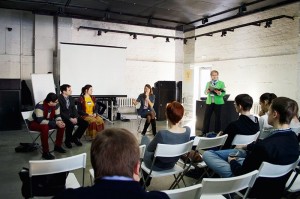
Now, back to Teplitza’s birthday that took place at the former “Flacon” factory in Moscow. They day started from a discussion that was focused on critical assessment of the role of online applications for NGOs.We discussed such problems as overload of innovative solutions, as well as the fact that the majority of users of these application is a small community of activists. When we asked the audience who use social application, unfortunately, very few hands were raised even despite the fact that this sample was totally biased and not representative because it was based on the people who were interested in this topic.
The birthday was also a good opportunity to summarize the activity of the first year and present some statistics:
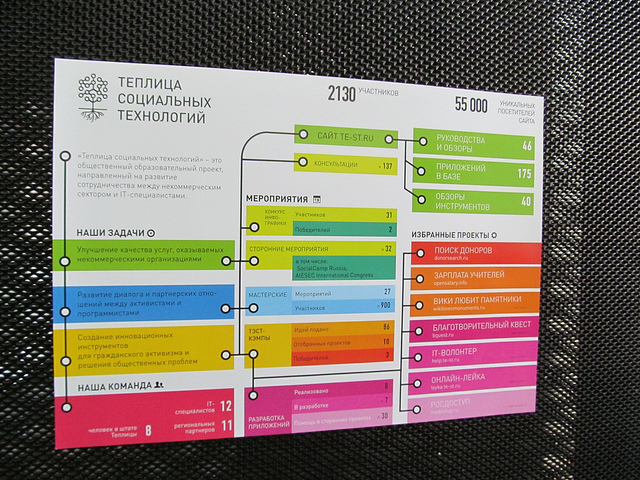
In one year “Teplitsa” conducted 137 consultations, completed 8 applications, while 7 are under development, and assisted with development of more than 30 other online projects.
It also conducted a variety of trainings and lectures from Wikipedia and Crowdmap to how to create a website from scratch in one hour (on the right Glafira Parinos talking about Crowdmap and Rynda.org).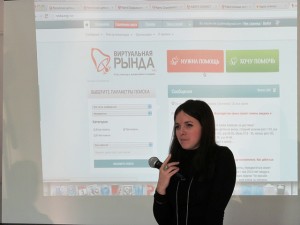 I prepared a new lecture about crowdsourcing that tried to conceptualize the idea of crowdsourcing in Russian context, which is especially interesting since the idea of crowdsourcing is adopted and harnessed by the Russian government (the term “crowdsourcing” appeared in presidential agenda of president Putin). That leads to interesting distortions and misrepresentations in understanding of what crowdsourcing means for the Russian audience.
I prepared a new lecture about crowdsourcing that tried to conceptualize the idea of crowdsourcing in Russian context, which is especially interesting since the idea of crowdsourcing is adopted and harnessed by the Russian government (the term “crowdsourcing” appeared in presidential agenda of president Putin). That leads to interesting distortions and misrepresentations in understanding of what crowdsourcing means for the Russian audience.
But the core of the day was a presentation of three projects that were developed with the support of Teplitsa and introduced on its first birthday. These projects are an interesting example of how supporting specific project can support the infrastructure of social activism and enhance social innovation among different sectors.
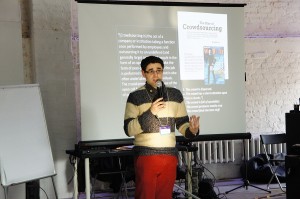 The first project is “IT-volunteer” – a platform that seeks to facilitate the dialogue between the community of NGOs and social activist on one side and the community of developers and web-designers on the other. Actually, IT-volunteer is a task manager that is focused on specific topics and specific communities. Every NGO can post a variety of projects and request for tasks that need to be done in order to create these projects. The task manager allows to define a range of awards for specific tasks as well as to post request for volunteer-based assistance. Any developer or designer can visit the platform and see what are the tasks on the agenda, if there any tasks that are “closer to their heart” since they address specific social needs and engage with these tasks. The platform is not only a management tool or a tool for the facilitation of dialogue, but also something that seeks to develop social awareness among community of developers.
The first project is “IT-volunteer” – a platform that seeks to facilitate the dialogue between the community of NGOs and social activist on one side and the community of developers and web-designers on the other. Actually, IT-volunteer is a task manager that is focused on specific topics and specific communities. Every NGO can post a variety of projects and request for tasks that need to be done in order to create these projects. The task manager allows to define a range of awards for specific tasks as well as to post request for volunteer-based assistance. Any developer or designer can visit the platform and see what are the tasks on the agenda, if there any tasks that are “closer to their heart” since they address specific social needs and engage with these tasks. The platform is not only a management tool or a tool for the facilitation of dialogue, but also something that seeks to develop social awareness among community of developers.
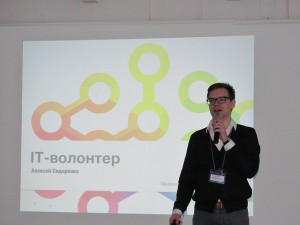 The second project is “Leyka”, which means “watering-can” in Russian. The name of project emphasizes the semantic field of “Teplitsa”. What green house can work without “leyka”? The purpose of “Leyka” is simplification of fundraising for social needs and management of fundraised contributions. It’s a “WordPress” plugin that can be installed at any WP website. Based on another WordPress plugin Easy Digital Download, it can work with variety of channels for money collection including 4 Russian systems plus PayPal, as well as traditional Russian bank accounts.
The second project is “Leyka”, which means “watering-can” in Russian. The name of project emphasizes the semantic field of “Teplitsa”. What green house can work without “leyka”? The purpose of “Leyka” is simplification of fundraising for social needs and management of fundraised contributions. It’s a “WordPress” plugin that can be installed at any WP website. Based on another WordPress plugin Easy Digital Download, it can work with variety of channels for money collection including 4 Russian systems plus PayPal, as well as traditional Russian bank accounts.
The third project is an “Audit Platform” that allows evaluating the efficiency and usability of websites for NGOs. It contributes to capacity of NGOs’ to be self-reflexive, and conduct independently monitoring and evaluation of their own online presence. The platform was developed by Anna Ladoshkina with Teplitsa’s support. The product itself comprises of two parts: self-evaluation mechanism (available on GitHub as miTest plugin) and ONWAM (Open Non-Profit Website Audit Methodology, a set of self-evaluation questions that can be edited and contributed to).
All the three platforms have a strong common denominator. They don’t focus on particular project, organization or goal, but can be considered as “enabling technologies” that enhance innovative environment and increase capacity to use ICT in a sustainable and efficient way for a variety of social goals.
Despite the innovation boom, no application or platform can provide a substitute to real birthday cake.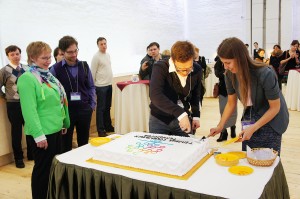 Moreover, no application can help to divide a cake to a real slices. Fortunately, “Teplitsa’s” director Alexey had the right skills in order to accomplish this mission with assistance of Daria Alekseeva, the editor of Te-st.ru portal (on the left).
Moreover, no application can help to divide a cake to a real slices. Fortunately, “Teplitsa’s” director Alexey had the right skills in order to accomplish this mission with assistance of Daria Alekseeva, the editor of Te-st.ru portal (on the left).
Certainly the second year of “Teplitsa’s” life will be full of challenges and opportunities. One of the challenge is public awareness and publicity. Online social projects should find a way to break the information cocoons (a concept that was suggested by Carl Sustein) and engage wide audience, otherwise it will remain a gadget for a small community, that might be able to perform that same activities without these tools. This problem is rooted in the reality with information and innovation overload where the struggle for resources and attention becomes more and more existential.
Hopefully, the project that demonstrated so far unprecedented degree of activity and fruitfulness will be able to address these challenges. Happy Birthday “Teplitsa” and wish you many new sprouts and bourgeons!